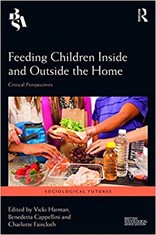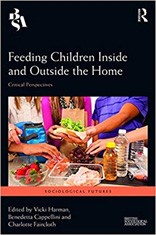By Vicki Harman, Benedetta Cappellini and Charlotte Faircloth


 Whether concerning childhood obesity, eating disorders or a resurgence of rickets, children’s diets remain a topic of concern for nutritionists, school staff, policy makers and parents. Such concerns mean that parents’ practices around feeding children often become the focus of media and policy attention.
Whether concerning childhood obesity, eating disorders or a resurgence of rickets, children’s diets remain a topic of concern for nutritionists, school staff, policy makers and parents. Such concerns mean that parents’ practices around feeding children often become the focus of media and policy attention.
From a sociological perspective, feeding children is not simply a matter of ensuring that nutritional requirements are met but it is about understanding the social context in which children are fed and consume food. Food practices are part of a rich social and cultural picture which are linked to parenting, school, family practices and consumption. Children are of course active players in shaping family food practices, often rejecting and requesting specific foods, and negotiating aspects such as when and where to eat (at the dining table? In front of the TV?). Certain foods can be used as a treat or a reward for good behaviour. Food is also an important area of cultural and social life allowing us to see how social divisions such as gender and social class are transmitted. Food can also be ‘read’ in different ways depending on where it is consumed. One example would be lunchboxes – food prepared in the domestic context but when consumed in the school environment may be interpreted in different ways by various social actors including children, school staff, and other parents. A lunchbox packed by a mother with the intention of stopping her child being worried about eating unfamiliar food in school, for example, might be read as containing too limited a range of foods or too much processed food.
Engaging with some of the above concerns, Feeding Children Inside and Outside the Home is a new book published as part of the BSA’s Sociological Futures Series. It brings together a collection of essays exploring feeding children inside and outside of the home across a range of socio-cultural and geographical contexts - from homes in Poland, Sweden, Denmark, England and Canada to schools and childcare settings in Portugal, England and Bolivia. Taken together, the chapters provide an inter-disciplinary conversation taking into account perspectives from sociological, anthropological, socio-historical and interpretive consumer research. Such a conversation seeks to address the following questions:
- What pressures are experienced when feeding children outside the home?
- To what extent do they build on, converge with or differ from those experienced in the domestic sphere?
- What are the implications for parental subjectivity when childhood eating has become so moralised?
The answers to these questions have been organised in three main sections. In Part 1, focusing on feeding children in schools and childcare settings, the authors provide new insights into the dynamics of feeding and eating practices outside of the home. Part 2, ‘The home (and beyond)’, focuses on domestic eating practices experienced by children and their families, but understands these as being connected to wider social structures and social processes. Part 3, ‘New parenting styles?’ draws our attention to potential new practices, ideas, ideals and understandings visible through research on parenting and food.
Here, we highlight three key themes that emerge from our reading of the chapters in the book.
1) Socio-economic inequalities
Food poverty continues to be an issue, as the number of families using food banks shows (in the UK and beyond). In Chapter 6, for example, Pamela Graham, Greta Defyter and colleagues explore the issue of food poverty and feeding children during the school holidays. As they say, “parents who are able to adequately feed their families through the school year with the aid of free school meals may find it very difficult to continue do so during the summer holidays when free school meals are unavailable” (p98). They review existing health and science literature to examine the potential impact of holiday hunger on childhood wellbeing before examining the way communities and local governments have established ‘holiday clubs’ to try to ameliorate the problem. Important questions are asked about whether these clubs should be available to all or only those most in need.
2) Moralising judgements
As many of the chapters show, immigrant families and working class families can bear the brunt of moralising judgements about families, visible in discourses and practices around food. Chapter 2, for example, written by Deborah Albon, draws upon ethnographic research in two early childhood settings in order to tease out some of the key differences in food practices in these contexts. She shows how children’s eating practices conjure up particular images of family life, with the same practice (such as finishing off breakfast from home ‘on the go’) being seen very differently in each context. She points to the importance of taking into account social class and ethnicity (of both the families and the educators) as well as power differentials and the type of setting.
Picking up on the notion of judgement, in Chapter 11 Katie Cairns, Josée Johnston and Merin Oleschuk highlight two pathologized and polarized extremes with regard to food work: the image of the woman who feeds her children only ‘“junk food’” and ‘“Organic Mom’”. They highlight the difficulty for mothers in walking a tight moral tightrope when trying to avoid stigmatization with regard to food work, with insecurity, frustration and guilt as often-present emotions.
3) Gender and food work
Linked to the above, gender is another key theme in many of the chapters in the book. In Cara Donovan’s study conducted in childcare centres in Bolivia, mothers were expected to be actively involved in shopping for food for the centres as well as attending their meetings. Whilst all parents could be fined for not attending, in practice this was only mothers who were penalised.
Michelle Webster’s chapter also shows mothers taking up the role of expert carer in implementing the ketogenic diet for children with epilepsy. A key point to emerge from this chapter is that a more ‘intensive’ parenting, often seen to be represented by food practices, is not always the result of cultural ideology, but can be the result of particular situations (such as treating epilepsy through the ketogenic diet).
There are hints at change too, with two chapters on fathers feeding the family. Susanna Molander’s chapter on Swedish fathers, who appear both actively involved in food work whilst also relaxed about it, offers us a way forward for thinking about how parents might move forward, rather than reinscribing difficult-to-achieve and competitive standards of intensive parenting.
In looking beyond the nutritionist-driven approach, then, this edited book provides new critical approaches to feeding children as a social practice influenced by a variety of institutions, norms, values and moral accountability. As such, the collection contributes to the literature on feeding the family and feeding children in diverse global locations, by engaging with theoretical debates around the moralization of feeding and eating practices, intensive parenting and everyday food consumption practices.
This represents a timely and interdisciplinary reflection on government and marketplace discourses of feeding children, as well as their relations to the micro and macro politics of family life. It also helps us understand how parents and children interpret and (and sometimes challenge) messages from health campaigns, governments, peers and others, as well as demonstrating change and continuity over time within individual experiences.
